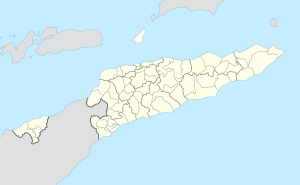Ambeno
Location in what is now East Timor
|
Ambeno ( Ambenu ) is a traditional empire of the Atoin Meto in the northwest of the island of Timor . Today the area belongs to the East Timorese exclave Oe-Cusse Ambeno .
Surname
The name of the empire, which is also used in the designation of the exclave as "Oe-Cusse Ambeno", is formed from two words. "Ama" or "am" means "father" or "king". "Benu" is the name of two legendary rulers of the region.
history
In the kingdom of Ambeno, the Portuguese landed on Timor for the first time in 1515 . Here they founded the Lifau settlement in 1556 . Later the kingdom of Oecussi arose here , which was controlled by the Topasse . This ruled over the coast in the northeast of today's exclave, while Ambeno occupied the mountainous west and south. The Cruz, the ruling dynasty of Ambeno, had a close relationship with the Topasse. There were alliances and marriages between the two kingdoms. Portugal's sovereignty over both was, however, rather nominal until the 19th century. The real power lay with the Topasse in Oecussi. In 1769 the Portuguese were even expelled from Lifau and had to build their new colonial capital in Dili . It was not until 1790 that Pedro da Hornay , ruler of the Topasse, and his brother-in-law, the ruler of Ambeno, again swore their allegiance on a trip to Dili Portugal. A priest had moved the two rulers to do so.
From 1861, the two empires no longer paid tributes or taxes to the Portuguese colonial administration. Only at the instigation of the missionary Francisco Xavier de Mello did Oecussi and Ambeno send representatives to Dili in August 1879 to renew the oath of allegiance. The ruler Pedro Paulo dos Santos Cruz came from Ambeno , along with five princes. The Portuguese gave the ruler of Oecussi the title rei ( German king ), while Pedro Paulo dos Santos Cruz the subordinate title coronel rei ( German roughly king colonel ). The colonial power made the hierarchy between the two domains in the exclave clear.
In May 1912, during the great Manufahi rebellion , there was also an uprising against the colonial rulers in Ambeno. All Portuguese in the empire who were not church members were brought to the seat of government by João da Cruz , Usif of Ambeno, and executed. Oecussi's ruler Hugo Hermenegildo da Costa , who remained loyal to Portugal, had to leave his empire at the time. The gunboat Pátria brought African soldiers and 150 Moradores stationed in Timor to Ambeno under the command of Capitão Pimenta de Castro . The rebellion was put down, including the destruction of the Church of Oecussi. João da Cruz fled to the Dutch part of Timor and Nunuheu lost his status as the seat of the ruler of Ambeno. João da Cruz's relatives, newly appointed by the Portuguese, settled in Tulaica . In addition, the kingdom of Ambeno was finally subordinated to the kingdom of Oecussi and Hugo da Costa.
Today's meaning
The ruler of Ambeno, who is called Liurai or Usif, still has an influence on local politics today. Even today, dignitaries of the various villages bring tributes to the ruling seat of Ambeno in Tulaica (Suco Lifau ) in the pre-Easter period . In some cases tribute payments are even made to Ambeno by villages in the Indonesian part of West Timor . The current Usif is called Carlos da Cruz (as of 2005).
See also
supporting documents
- Laura Suzanne Meitzner Yoder: Custom, Codification, Collaboration: Integrating the Legacies of Land and Forest Authorities in Oecusse Enclave, East Timor. Dissertation, Yale University, 2005 ( PDF file; 1.46 MB ( memento of March 7, 2007 in the Internet Archive )).
Individual evidence
- ↑ Information page from Oecussi-Ambeno from 2007: Politics ( Memento from July 6, 2007 in the Internet Archive ) (English)
Coordinates: 9 ° 16 ′ 26 ″ S , 124 ° 20 ′ 50 ″ E
